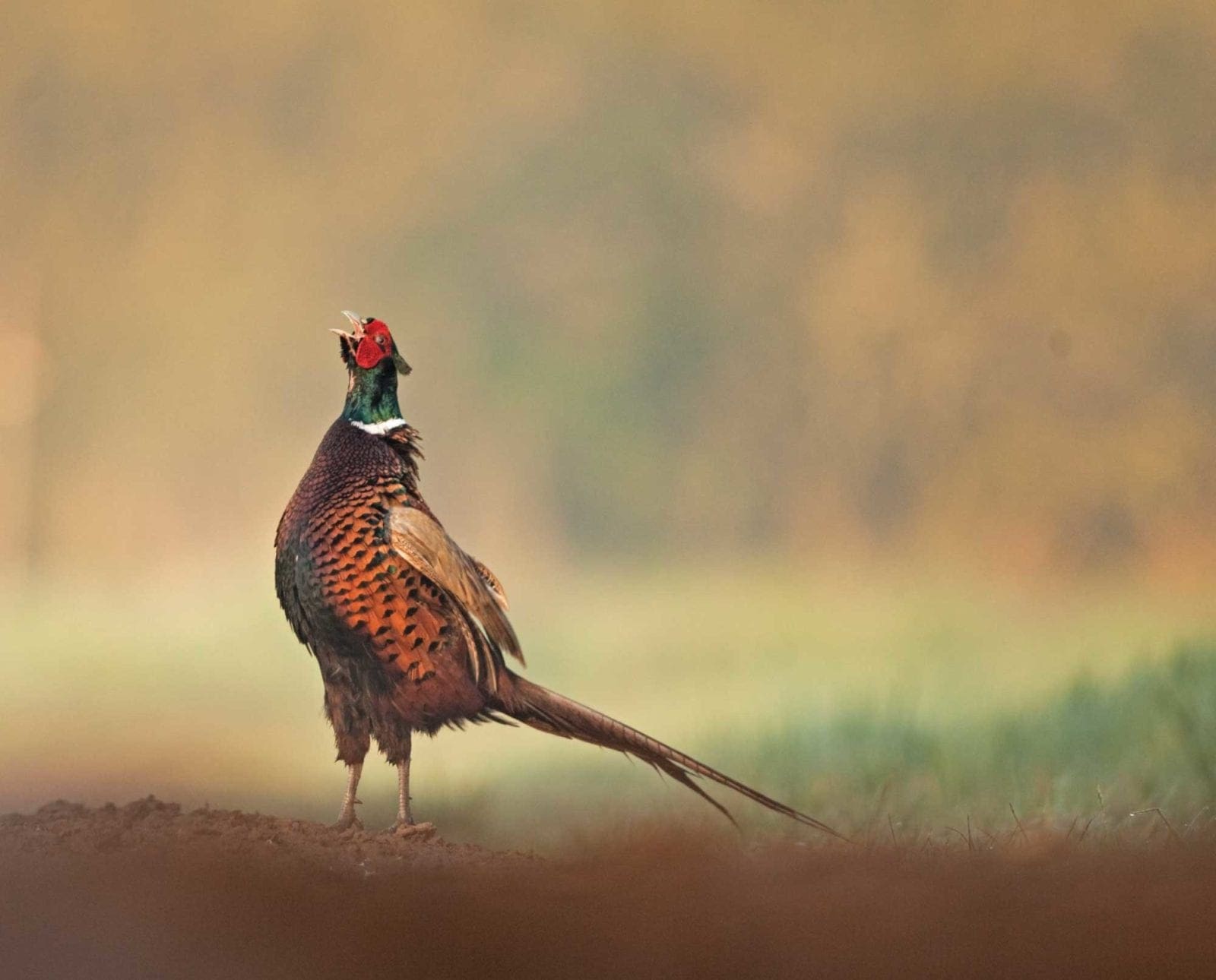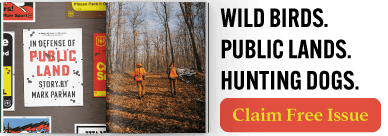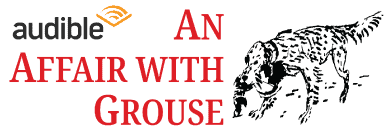Home » Conservation » What is the Call of the Uplands Initiative?
What is the Call of the Uplands Initiative?

Andrew Spellman is an award-winning photojournalist and author. A 2017…
Uncovering Pheasants Forever’s groundbreaking initiative to save upland birds and habitat
WASHINGTON, D.C. – The uplands are calling; how will you answer?
That’s what Pheasants Forever (PF) asked when it launched its new campaign, Call of the Uplands, a five-year, $500 million national effort to recruit and educate a new generation of hunters while also protecting, restoring, and conserving upland habitat.
“Call of the Uplands is Pheasants Forever and Quail Forever’s historic effort to conserve North American upland habitats,” said Jared Wiklund, the organization’s public relations manager. “It’s based explicitly on bold science. We’re using science from the National Pheasant Plan, the National Bobwhite Conservation Initiative Plan, using focus areas and the best science possible, to put grasslands, birds, and upland hunters back on the landscape.”
The organization has set goals to enhance more than 9 million acres of habitat “from the West’s expansive landscapes, to the vast Great Plains, to the quiet southern pine woods,” and protect 75,000 acres in perpetuity. According to the organization, over 53 million acres of grasslands have been lost in the Great Plains since 2009 and of the 90 million acres of longleaf pine woodlands that used to cover the southeast region of the country, 97 percent is gone. Further, PF notes that bird populations, too, have seen declines, with Northern Bobwhite quail populations falling by 83 percent from 1966 and pheasants by 70 percent from 1970.
How many acres?
When broken down, the organization plans to protect and restore the 9 million acres of high-quality habitat in strategic locations across the country, with most of the focus on the central third. There, from North Dakota and Minnesota down to Louisiana and Texas, PF plans to enhance 5.8 million acres. On Western landscapes, it’s targeting 2.4 million acres, and in the East, 910,000 acres. Permanent protection will be secured through fee-title acquisition and conservation easements, and other plans include partnering with landowners.
The launch of Call of the Uplands comes after the Conservation Reserve Program (CRP) hit an all-time enrollment low in December 2020, rallying slightly to 21.9 million acres in February 2021. PF will continue to work with private landowners to boost interest in the CRP program, too, as they always have. Should they accomplish this, grassland bird populations will recover as well.
“From the other perspective, too, you look at Pheasants Forever and its relationships with the agricultural community right now: we’re expanding greatly into the area of precision agriculture,” Wiklund said. “We work hand-in-hand with farmers, agriculture cooperatives, and crop consultants to help landowners target the best acres on their property.”
Wiklund also notes the use of precision agriculture, which uses technology to identify under-performing acres in farming operations. PF then helps landowners understand the data to enact management and conservation programs to boost profits on low-yielding areas.
“We’ve seen a monumental shift in the last 3-5 years of working side by side with agricultural producers to help analyze their farming operations, install beneficial wildlife habitat, soil health and water quality programs in areas of low profitability,” Wiklund said, “which improves sustainability, helps wildlife, and helps make them more dollars per acre; the return on investment is greater. Just think what you could do by adding a couple million more acres of grass to the landscape every year. We can do some good things for upland wildlife.”
While boots-on-the-ground action will be easily identified on the nation’s grasslands, another significant portion of the campaign will play out on Capitol Hill led by a coalition of nonprofit policy agents.
The push for legislation
While some new hunters or conservationists weren’t around for the authorization of the North American Wetlands Conservation Act (NAWCA) in 1989, it’s hard to miss today the benefits it had for wetland habitats and the wildlife that utilize them.
According to data reported by The Hill in February 2020, NAWCA has supported $1.6 billion in federal grants that have turned into $6 billion when combined with matching non-federal and private partnerships. Further, the entire $6 billion has been funneled into wetland restoration and conservation, which in turn has supported more than 2,900 projects on over 30 million acres of wetlands and grasslands in every state. Additionally, data released by Ducks Unlimited in 2018 showed the program has also been a successful job-creation tool, supporting nearly 7,500 jobs on an annual basis which generate $200 million in earnings.
NAWCA was just reauthorized in 2019 as part of America’s Conservation Enhancement Act—a major win for the country—and Pheasants Forever is hoping to ride the momentum from that to see a NAWCA-like bill that focuses on grasslands passed by Congress in the future.
“We know, and most upland hunters and wildlife enthusiasts in general know, that the future of wildlife and wildlife habitat in the U.S. can be rapidly altered with the stroke of a pen in Washington D.C. or in state capitols,” Wiklund said.
“The concept of a sort of NAWCA-like grasslands program has been around for quite a while, and within the past year there’s been a couple of things come together,” added Pheasants Forever Government Affairs Representative Bethany Erb. “One was the TRCP sportsman’s climate recommendations which we were involved with, and then as we sort of anticipated a new administration may take hold that climate would be a big focus. Then, 30 by 30 came along. But thinking about how grasslands will tie into future policy and climate initiatives, we started putting our heads around maybe this is the time we introduce some expanded grasslands policy. That’s how it came about.”
Though the name “North American Grasslands Conservation Act” has circulated, Erb noted that the legislation doesn’t have a name yet, simply because it’s not legislation yet.
Being in the preliminary stages, Erb and partners are still putting together strong data that shows grass’ ability to sequester carbon, talking dollar amounts, and piecing together what all groups and wildlife species they want to target. There are talks of including sovereign nations in the legislation and rolling in sagebrush ecosystems but, according to Erb, “That will be a conversation we need to have with House and Senate resources staff to see what’s doable, what’s achievable.”
To emphasize how important legislation is for conservation efforts, PF notes that “73 percent of America’s tallgrass, mixed-grass, and shortgrass prairies have vanished, along with their ecological benefits and many iconic species,” and although pheasants and quail numbers are at the forefront of the initiative, “some species, like the lesser prairie chicken, teeter at the edge of extinction. Species that had been economically significant throughout American history.”
If all of this goes as planned, it will be a significant win and boost projects in the short-term, something politicians will love since re-election is a constant factor in their decision-making. But to truly make a long-term difference, PF is leaning on a strong education that will live on for generations.
Read: What to Expect from the Next Pheasant Fest 2022
Education and outreach
Pheasants Forever states that through Call of the Uplands, it will reach 1.5 million people with “new and expanded education and outreach programs to engage them in outdoor recreation, shooting sports, hunting and habitat conservation.”
One of the main pillars, education comes with three supports: habitat education, conservation leadership, and hunting heritage.
In a digital world, and in a time when communication can fall by the wayside, Pheasants Forever has emerged as a leader in combining the two. With Path to the Uplands, a new content series will deliver stories that focus on different mediums, PF will give people “more pathways to becoming a hunter or taking up hunting again.”
“We all utilize these beautiful wide-open spaces and have a passion for the serenity that is provided by upland wildlife habitat, but we have different motivations that drive our interest in these common grounds… and that’s okay! The presentations for this stage will aim to tell a compelling story based on unique individual’s ‘Path to the Uplands’ including how they got involved, why they are still connected, and how you can help get others involved,” Colby Kerber wrote for PF in late December. “There are so many reasons why people spend time in the uplands and a variety of starting points (public lands, women’s events, shooting sports, mentoring, etc.) so hopefully the presentations will inspire new people to find their own ‘Path to the Uplands’ and encourage current outdoor enthusiasts to engage others along the way.”
And according to Rich Wissink, PF’s vice president of education and outreach, strong communication and game-planning for a wide swath of the hunting community, now and in the future, is key.
“I think facts, and in this case, science-based solutions matter to the majority of people across our country; and they are especially important to an organization whose mission is the conservation of pheasants, quail, and other wildlife through habitat improvements, public access, education, and conservation advocacy,” Wissink said. “For our grasslands, education is imperative as it allows us to make sound, conservation decisions on a landscape which impacts us all. While our upland communities, and grasslands specifically, are the most threatened and challenged habitat types in North America, few people are advocating for their conservation. In fact, grasslands are the fastest disappearing ecosystem in North America.”
Wissink further noted that the demands on grassland landscapes are high, relaying that healthy grassland/upland habitats are robust and the most diverse habitat types there are, and that they provide an incredible amount of recreational opportunity; the landscapes in which they are found are also some of the hardest “worked” landscapes in the world. They produce food and a wide variety of sources for energy; and when intact, they provide an incredible amount of environmental quality benefits.
“The entire country benefits from clean air and water, soil protection, and a healthy environment to live in,” Wissink said.
As far as education, Pheasants Forever will stand behind educational programs that teach outdoor skills, how to hunt for all ages and genders, and show communities the importance of pollinator habitat and how that helps other wildlife. They will also continue work they’re well known for: partnering with farmers and ranchers to include wildlife habitat and conservation practices alongside their operations and informing and engaging volunteers, members, and partners on conservation advocacy issues.
“Whether you hunt, fish, farm, ranch, bird watch, are concerned about native pollinators, care about our climate, enjoy accessible wild places, or just plain care about wild places and the wildlife that live there, you must be part of the solution to this North American conservation crisis,” Wissink said.
Trust is a major factor in accomplishing both short- and long-term goals, so how will Pheasants Forever build that? Essentially, by catering to different interests and age groups.
“Specifically, in regards to the North American hunter conservationist, trust will come through developing and offering programs, resources, information, and opportunities that meet the specific needs of a variety of audiences,” Wissink said. “We recognize that there are different motivations for each individual to show an interest, and/or engage, in hunting. If we are to be successful, we must provide them with an organization and community that meets their needs and desires for engagement. That is why we have expanded our traditional learn-to-hunt events for young or novice hunters, to authentic experiences that have been designed specifically to reach a larger audience, knowing that the uplands are for everyone, regardless of age, gender, or race, and we want that reflected throughout the organization and the greater upland community.
“Cultivating that culture of belonging at Pheasants Forever and Quail Forever is important to our mission and continued conservation relevance. We know our mission is important to everyone and we need members, volunteers, supporters, and partners that represent the diversity of the people that make up this great nation and our hunting traditions.”
Wissink ended on one last question: “If those of us who care most about our upland habitats and the wildlife that live there don’t act now, who will?”
So, how will you answer the call of the uplands?
Andrew Spellman is an award-winning photojournalist and author. A 2017 graduate of West Virginia University's Reed College of Media, Andrew's work has appeared in multiple newspapers and magazines. He is also an avid hunter and angler who enjoys chasing varying game in his pocket of Appalachia.



